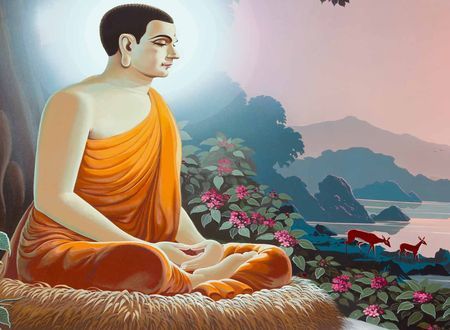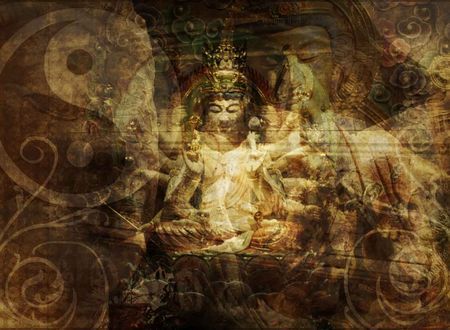This post brings to you an actual practice on the road to self-transformation. The first practice on the path of self-transformation is the art of observing silence.
Not necessarily the first one you need to perform, just the first one I am elaborating on. Observing silence can help you achieve silence of the mind. The term for observing silence is mauna in Sanskrit. Interestingly, in the Bhagavad Gita mauna is defined as tapas, penance, of the mind:
bhāvasaṃśuddhirityetat
tapo mānasamucyate (Bhagavad Gita 17.16)
Thus: A cheerful disposition, an even temperament, self-reflection and contemplation, a quiet mind, and purity of bhava make up austerities of the mind.
The human mind is always talking. It is not possible to listen to your mind if you are talking as well. It is, furthermore, impossible to quieten your mind if you are not paying attention to what it is saying. And, in order to listen to your mind, you must be quiet. Quietude of speech is paramount to attain complete quiescence of the mind.
As part of the practice of silence, you need to start with small periods first. The shortest being at least one straight stretch of twenty-four hours. If you are merely observing silence of the speech by refraining from speaking, you are only fifty percent there. The practice involves observing complete silence; that means, not holding any type of conversation. Carefully examine the chart below:
As an analogy, think of taking a driving test. When you are behind the wheel with the testing officer next to you, it is clear to you that certain mistakes are considered ‘Instant Failure’ items while there are other points where a degree of leniency is used. If you fail to indicate while turning or fail to check your blind spot when changing lanes, for example, your test is terminated right at that moment and you are asked to turn back. Whereas, if you are not ultra vigilant in constantly checking your rear and side-view mirrors and are only doing so intermittently, you may still pass.
Similarly, all practices henceforth are going to have items classified as ‘Instant Failure’, ‘Warning’, and ‘Need Improvement’. Under the Impact column in the table above, red markings are an instant failure, yellow, a warning, and green are to be taken as areas for improvement.
For instance, you undertake the practice of observing silence for forty-eight hours. During that time, if you make any verbal comments, the impact is red and huge and basically that is an instant failure. If you end up reading a newspaper etc during those forty-eight hours, the quality of your practice comes down by five percent (see the weightage column); you can still continue because it is a ‘green’ mistake.
During your period of silence, you can at the most take one book at the beginning. But ideally, you should just be in a room in your own company. If you end up sleeping for eighteen out of twenty-four hours just because you can or because you have nothing else to do, you need not bother with this observing silence business. It is wasting your time; after all, we are not observing sleep but silence.
The more mindful and alert you are, the better your practice. When in complete silence, you will start to become aware of the talkative nature of your mind. You will begin to see how your mind is restless like the baboon that cannot stay on any branch for longer than a few seconds.
Initially, your ability to meditate is going to retard while observing silence. You are likely to experience a certain restlessness as well. You need not be alarmed. It is only natural. With persistence and patience, a quietude will begin to dawn. And that is going to get you ready for good meditation. Observing silence is comparable to preparing fertile ground to sow the seeds of meditation.
Please know this: the practice of observing silence is absolutely critical for the seeker desiring to experience a state of superconsciousness. When you are enjoying yourself listening to your iPod, the external noise seems to subside automatically; the music in your ears makes the outside sound almost immaterial. Similarly, when you are able to channelize internal noise, it transforms into music. And when you start to hear internal music, everything offered to you in the external world almost ceases to matter.
A good practice of silence does not have any dialogue, conversations — written or oral, gestures, interactions or engagements. Mauna is not merely the restraint of speech, it is quietening your actions, speech and thoughts. A saguṇa upāsaka, worshipper of form, is allowed to eulogize his deity during the period of mauna. His primary objective of observing silence is to strengthen his own devotional sentiments towards his deity as opposed to mere quiescence of the mind.
Somewhere along the line, I will find a placeholder to narrate my personal experience(s) on hearing the anahat nada, the unstruck sound, and how anyone can get to it; at will, at any time. It is a natural outcome, among many others, of silence and solitude.
In the next post in the series, I shall outline the practice of solitude as part of mental transformation.
To understand the importance of silence, you can read up again on the article on conversations.
Peace.
Swami
A GOOD STORY
There were four members in a household. Everybody, Somebody, Anybody and Nobody. A bill was overdue. Everybody thought Somebody would do it. Anybody could have done it but Nobody did it.
Don't leave empty-handed, consider contributing.It's a good thing to do today.










Comments & Discussion
17 COMMENTS
Please login to read members' comments and participate in the discussion.